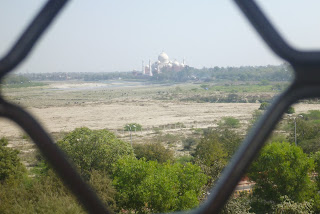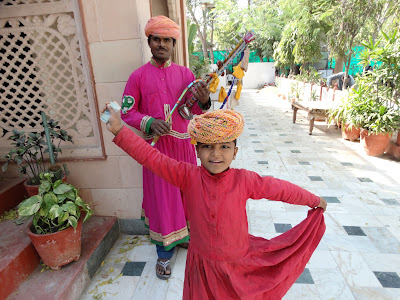 |
| A Foggy? Smoggy? Morning |
Sunday and the Living Is Easy.
Before we drove out of Agra we stopped one more time along
the road to take a good bye picture of the Taj Mahal. We were in for a long bus
ride. 10 hours to get to the tiger preserve, including stops every couple of hours
for meals, bathroom breaks and one sightseeing spot..
 |
| Fatehpur Sikri |
 |
| One of the Main Pavilions |
 |
| Struts In the Form of Serpentine Scrolls Coming Out of the Mouth Monsters (click to see more detail |
 |
| This Is Where the Elephant Was Tethered |
The sightseeing stop was the ‘Ghost’ Capital by the name of Fatehpur Sikri, a (UNESCO) town (1571-1585) that the famous Mogul Akbar wanted to establish, but the lack of water was so severe that the town and the palace were just abandoned. One spot within the palace was a large loop, secured in the ground, where an elephant used to be tied up. If someone was given the death sentence he was stomped to death by this elephant. Near to it, a Parcheesi board was set up, where the emperor played Parcheesi; using live people he ordered to move about on the board. It was not clear to me if he played Parcheesi while the execution was going on or
not.
Nearby are the oldest hills (mountains) in India, the
Aravalli range. Those ancient mountains are a wonderful source for garnets and
emeralds.
All we did was ride the bus; get to the
hotel and sleep, with just a few stops in between. India is a large country;
the distances between major hubs are great distances. We saw more greenery along the way, slowly
turning into desert-like surroundings, well maybe not pure desert but much more
arid and in need of rain.
So I take this bus ride time to chat about:
Jain: a branch of
Hinduism where the people do not believe in any personal possessions. Their purpose on Earth is to “do no harm”. Jainism has been around since 550 BCE.
Some Jains do not even wear clothes, yes they walk around nude. Yes, we met
Jains but not this extreme kind. All Jains are pure vegetarians and none wear
any kind of animal skin like leather, furs, etc. The Jains I met all ran
businesses.
Sikhs: (Sikh men wear
turbans, they never cut their hair.)
Philosophy and Beliefs:
There is only One God. He is the same God for all people of all
religions.
The soul goes through cycles of births and deaths before it
reaches the human form. The goal of our life is to lead an exemplary existence
so that one may merge with God. Sikhs should remember God at all times and
practice living a virtuous and truthful life while maintaining a balance
between their spiritual obligations and temporal obligations.
The true path to achieving salvation and merging with God
does not require renunciation of the world or celibacy, but living the life of
a householder, earning an honest living and avoiding worldly temptations and
sins.
Sikhism condemns blind rituals such as fasting, visiting
places of pilgrimage, superstitions, worship of the dead, idol worship etc.
 |
| Colourful Sari |
All Sikh people are named Singh, but when you meet a Singh
it does not means he/she is a Sikh.
Even though Sikhs and Jains denounce Hinduism, Hindus seem to consider all other religions as an offshoot of Hinduism. India is a melting pot
of all religions. Religious freedom seems paramount, and the laws of the land
are adaptable to the religion you declare on your citizenship papers. So yes,
you may walk around nude and you may marry and have 4 wives, etc. it all
depends on what religion you practice, I guess.
“pur” and “bad”. If
the town ends with -pur (Jaipur) it's a Hindu town; If it ends in -bad (Allahabad)
it's a Moslem town.
Maharajah: Maha =
big. Rajah = King. So, it means big King or Emperor. This set up of a main
Chieftain was around before Islam invaded India.
Rajasthan means King’s Land, or land of the
Kings. In fact we are on the way to the state of Rajasthan, and it was explained to me this
way:
As we know Maharajahs had many children and only one could
inherit the throne. What to do with all the other sons? Daughters were married
off and moved in with their husband’s family. But what do you do with all the
extra sons? Infighting, deporting, eliminating your rival brother was part of
life then, only the smartest, strongest would survive. It's the law of
survival, its competition.
 |
| Such Big Eyes You Have |
It becomes really complicated when Islam arrives, now two
laws, two ways of looking at succession need to somehow fit the daily life. No
wonder India had a Warrior’s Caste, those petty Kingdoms and later the Moguls
fought each other tooth and nail all the time.
Amazing India! Rajasthan
women wear the most colorful saris.














































